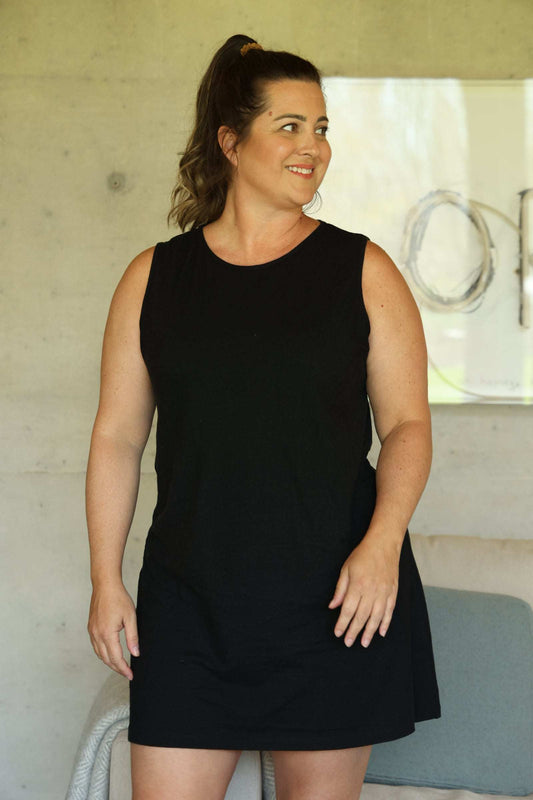
The Best Fabrics to Sleep In When You Have Night Sweats (and Why They Actually Work)
Share
If you’re waking up clammy, drenched, and exhausted every morning—and/or in the middle of the night—thanks to night sweats, you’re probably wondering if you’re ever going to get a good night’s sleep again. One of the major culprits that could be making your night sweats worse might just be your sleepwear and bed linens fabrics. In this article we’re going to highlight the best fabrics to sleep in so you stay dry and comfortable all night long so you wake up refreshed. Yes! It is possible!!
If you’re in perimenopause or post-menopause, night sweats and hot flashes are the most common (and annoying) symptom. Night sweats can be debilitating because they rob you of your sleep.
Fabric can have a big influence on your sleep—especially if you have a hair-trigger internal thermostat that sets off for no reason, sending out an incorrect signal to your body that it needs to cool down—stat!
The problem is, the most common fabrics for sleepwear and bed linens—cotton and polyester—also happen to be the worst for night sweats, trapping both heat and moisture under the covers, making your night sweats worse.
If you missed our post on what not to sleep in when you have night sweats it’s a good primer on fabrics that make your night sweats worse.
Why does fabric science matter when you sweat at night?
Gone are the days when you could sleep in and under anything in any room temperature. What you sleep in now matters. The right fabrics promote moisture wicking and heat management so you stay dry and comfortable. The wrong fabrics trap more heat and moisture, increasing how often your body triggers another cooling cycle.
It all comes down to fibre structure—how each thread interacts with temperature and moisture.
A breathable fibre allows air to circulate and releases heat quickly; a dense or coated fibre traps it next to your skin.

What makes a fabric great for night sweats?
To reduce the number of night sweats during the night, you need a fabric that manages heat and moisture fast enough that your body never fully overheats. That means you sleep longer, flip the covers less, and wake up more refreshed.
Less cover flipping = better sleep = better mornings.
The fabric must actively respond to heat and moisture—not just absorb them. As we explained in our worst fabrics for night sweats post, most common materials simply can’t keep up.
And it’s not only about fibre type—it’s also about weave and weight. For night sweats, light- to medium-weight fabrics made from natural, breathable fibres perform best.
Why is hemp (and hemp-cotton) so effective for night sweats?
Hemp is an incredible natural performance fibre. Each hemp strand has a hollow core and porous walls that absorb and release moisture rapidly, helping you stay dry through the sweatiest parts of the night. While most heat escapes, that hollow core retains a touch of warmth to ease the “chill phase” that follows a sweat cycle. The result: more stable body temperature and uninterrupted sleep.
Hemp is also strong, long-lasting, and naturally antibacterial. When blended with soft fibres like cotton, it creates a supple, breathable fabric that gets even softer over time.
That’s exactly why our Simone Nightgown and Vanessa PJ Set use a hemp–organic cotton blend—the perfect mix of softness, strength, and thermoregulation.
Is linen a good fabric for night sweats?
Yes—linen is another superstar for moisture management. Like hemp, it’s part of the bast fibre family and has a natural hollow structure that wicks heat and sweat away fast. High-quality linen gets softer with wear and can last for decades.
Because linen wrinkles easily and is often woven rather than knit, it’s best suited for bedding and pillowcases rather than fitted pajamas. Pairing linen sheets with hemp-cotton sleepwear is an ideal combo for staying cool and dry all night.
How well does lyocell (Tencel) work for night sweats?
Lyocell—also known by the brand name Tencel—is a semi-synthetic fibre made from wood pulp. It retains many of the breathability benefits of plant cellulose, making it better than polyester or traditional rayon, but not quite as thermoregulating as hemp or linen.
It’s smooth, soft, and moisture-absorbent, but can pill or tear more easily, and tends to trap a bit more heat than linen or hemp. Lyocell can be a good option for those with very sensitive skin—but it won’t manage temperature as dynamically as hemp.
What about bamboo, viscose, or rayon fabrics?
Viscose and rayon (including bamboo) are also semi-synthetic cellulose fabrics. While marketed as “natural,” they’re heavily processed with chemicals that can affect both their environmental impact and performance.
They do absorb moisture—but much like cotton, they hold onto it, leaving you damp instead of dry. Lightweight versions may dry faster but lose their insulating balance, leading to hot-and-cold cycles through the night. These fabrics also weaken when wet, so garments wear out faster.
If you’ve been buying bamboo PJs thinking they’re better for night sweats, check out our post on why we don’t love bamboo and neither does the US Federal Trade Commission.
How do your bed linens affect night sweats sleepwear?
Even the best nightwear won’t keep you dry if your bedding traps heat. If your sheets or blankets are made from synthetics or heavy cotton, they’ll hold onto moisture and stop your sleepwear from working effectively.
Download our Fabric Guide to learn how to choose the right materials for every sleep layer—from pajamas to thermal blankets—and finally sleep comfortably all night.
Why CoolYourSweats sleepwear works
I created our sleepwear after years of waking up drenched and exhausted due to night sweats. Cotton and bamboo didn’t work, so I turned to my background in natural materials to uncover why.
The result is our hemp–organic cotton blend: breathable, quick-drying, thermoregulating, and naturally antibacterial. Our sleepwear is designed to move moisture away from your body, help you stay cool, and feel comfortable. Customers often tell us they can’t sleep in anything else.
Ready to see how it feels? Shop the Collection Once you discover fabrics that keep up with your body, sleep feels effortless again. You’re not fighting your night sweats—you’re working with them.




